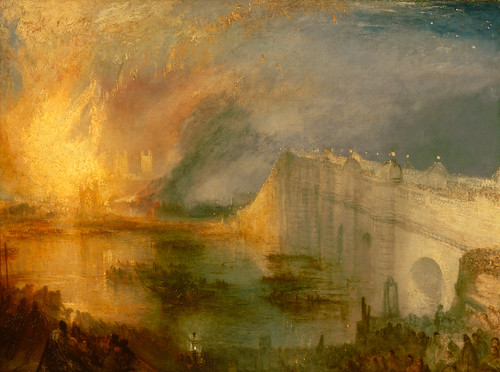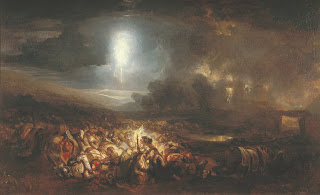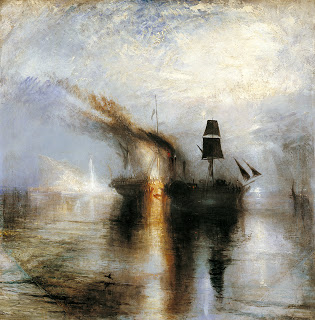The Sublime Turner and Contemporary Fibre Art

J.M.W.Turner The Burning of the Houses of Lords and Commons, October 16, 1834 (1835)
Philadelphia Museum of Art
Billed as the largest Turner exhibition ever seen in the U.S., the retrospective currently at the National Gallery of Art is a joy even for those who know his work well (through January 6, 2008, www.nga.gov; Philadelphia viewers will have a second chance, after its Dallas venue, when the exhibition travels to the Metropolitan Museum of Art June 24 – Sept.21,www.metmuseum.org). Turner’s work is always fresh, and this wonderful selection of 146 oils and works on paper shows an artist whose early work already conveyed a grandeur and whose mature paintings would have a profound influence on later nineteenth and twentieth-century art.
From the beginning Turner saw nature as an active subject, preferring scenes that revealed the drama of storms, rainbows, waterfalls and changing light – of both sun and moon – caused by moving clouds. His paintings tend to include human figures, usually in a losing battle with nature. As the exhibition makes clear, this was part of a larger Romantic interest in the sublime, theorized by writers such as Edmund Burke. And it was part of Turner’s ongoing fight to have landscape taken as seriously as history painting (which could include contemporary scenes as well as those drawn from the Bible, literature and actual historic events).

J.M.W. Turner The Field of Waterloo (1818) Turner Bequest, Tate Gallery
The exhibition includes three massive depictions from Britain’s battles in the Napoleonic Wars: The Battle of Trafalgar, as seen from the Mizzen Starboard Shrouds of the ‘Victory’(1808), The Field of Waterloo (1818), and his largest painting and only royal commission, The Battle of Trafalgar, 21 October, 1805 (1823-4). The last depicts Nelson’s ship, the Victory, in front of which half-clothed, desperate men cling to lifeboats, as in Gericault’s Raft of the Medusa (which had been exhibited in London in 1820). Surely no other artist commemorating the victor showed such bleak scenes, lacking in bombast or triumph. In The field of Waterloo women pick through a mass of tangled bodies for the remains of their men, as a house burns in the distance. The painting was exhibited, but never found a buyer.
The exhibition would be worth seeing if only for a room devoted to two paintings and ten watercolors of the burning of the Houses of Parliament in 1834. Turner witnessed the fire, which embodied his ongoing interest in the violence of the elements and presented an instance where landscape was inherently the subject of a major historical event. One of the paintings is from the Philadelphia Museum of Art (it’s used on the catalogue’s cover, the second time this year that a PMA work is on the cover of an NGA exhibition catalogue!), the other from the Cleveland Museum of Art, and they show that the artist crossed the Thames to observe the blaze from multiple viewpoints. It’s an extraordinary opportunity to see them together and in the company of the studies (note: the Cleveland painting will not travel with the exhibition to New York).

The exhibition is notable in showing works made for a range of purposes: sketches on paper, canvas and wood and highly-finished works on paper and canvas; sample paintings, made to give the patron a choice of subjects; paintings commemorating public events, such as the war scenes, and private ones, such as his superb tribute to the painter, David Wilkie : Peace – Burial at Sea. And then there’s the final room with its group of unfinished works. Turner’s unfinished canvases have always appealed to the taste of late 20th and 21st century viewers, attuned to abstraction; but it’s important to understand that these almost-abstract works are only part of Turner’s conception, and would have been finished with further details. I saw an ideal exhibition of them in 2000 at the Tate Liverpool, where they were hung without frames, to emphasize their provisional status (and in natural light!). That struck me as the perfect way to present them.
Collecting Contemporary Textile Art
The Textile Museum(www.textilemuseum.org)is one of my favorite D.C. museums and has a worldwide following, but tucked away as it is, a 10-min walk from the Phillips Collection, it’s off the radar of too many art visitors to D.C. That should change next year when the museum opens new exhibition galleries (and their fabulous gift shop) on 7th St., on the same block as the Shakespeare Theatre and a five-minute walk from either the Mall, to the South or the Smithsonian American Art Museum/National Portrait Gallery to the North.
But for now it’s worth finding your way to their original facility at 2320 S. St. N.W.for a very broad overview of the use of fibre in contemporary art. The exhibition, organized around work from several private collections (hence its title: Private Pleasures; Collecting Contemporary Textile Art, on view through Feb. 17, 2008), includes weaving, quilted work, embroidery and basketry by a range of artists with formal training in textiles as well as work by artists from other disciplines who turned to fibre for the construction of prints, multiples and costumes for performance. Philadelphians might see it as a marriage of the approach taken by the Philadelphia Museum of Art’s Craft department and that of the Fabric Workshop and Museum.
The exhibition includes four pieces by Ed Rossbach, a grand old man in the field of basketry who brought a sophisticated and conceptual approach to the practice. My favorite was his Origami Basket with Mickey Mouse (dated prior to 1981). He used the Japanese technique to fold a piece of paper on which he’d drawn his version of Mickey, making a seat for a chair-like form composed of twigs. It comments on the globalization of popular culture and the denigration of traditional craft; but what also interests me is its parallels with Claes Oldenburg’s Mouse Museum (1972), a structure with the plan of a mouse’s head that housed Oldenburg’s collection of small objects, mostly mass-produced and purchased at dime stores, occasionally altered by the artist. Both artists were interested in the effect mass culture has upon our perception of reality and of art.

Nick Cave Soundsuit – Black (2005) collection Peggy Cooper Cafritz, D.C.
A basket by Jan Hopkins, Chameleon (2001), is made of bits of grapefruit peel stitched together; it made me think of Zoe Leonard’s Strange Fruit (for David) (1992-97, collection PMA); but where Leonard’s elegiac work is intended to decay, I assume Hopkins has treated hers to last. Another basket by a major figure in the field, John McQueen, is the almost life-size Beside Myself, (2000), a sculptural self-portrait in which his own form clutches and merges with one of the baskets that have defined his reputation. Nick Cave’s Soundsuit – Black (2005) was part of a performance, and like the McQueen piece, it’s an exploration of the artist’s identity (in Cave’s case, as a black man). The dress-like costume with matching balaclava (sans eye-holes) is made of cast-off black socks that Cave has sutured together with visible stitching. Sequins add a further touch of absurdity to his improbable garment.









